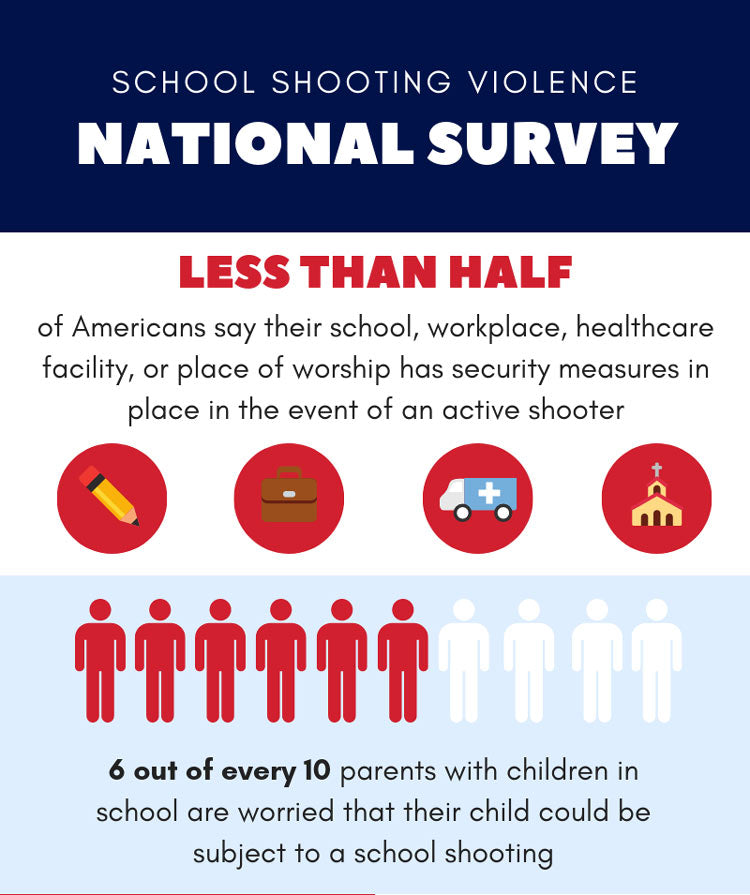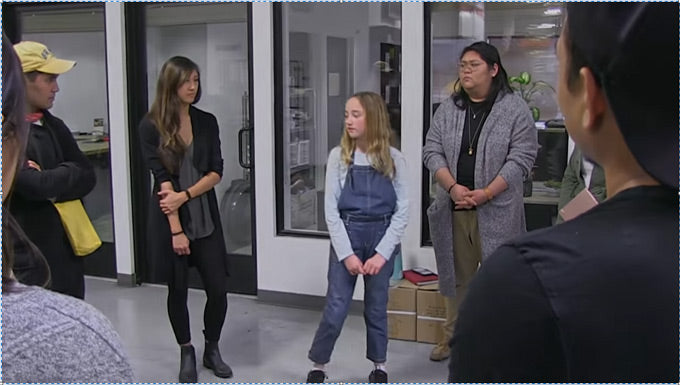Why We Need Lockdown Devices for Classroom Doors
It’s everyone’s worst nightmare.
News spread about violence in a nearby school.
Parents rush to school.
Sounds of sirens, crying, and shouting are all around.
What’s worse: IT COULD HAPPEN TO ANYONE.
No one could’ve prepared for what happened at Columbine High School in 1999, or Sandy Hook Elementary in 2012.
At Stoneman Douglas High School, no one could fully understand why a school shooting happened in 2018. In 2007, the deadliest school shooting happened at Virginia Tech.
Before the Columbine Shooting Incident, a school shooting was unfathomable.

Photo: Ross A. Catrow | Flickr.com | CC BY-SA 2.0
Year after year, school shooting incidents have been happening all across the country. Schools, which should be sanctuaries for children, are now considered unsafe.
In 2019, a poll showed that 34% of parents are concerned about their child’s safety while they’re at school.
Why is it becoming unsafe? Classrooms are NOT built to keep BAD PEOPLE OUT.
Shooters were able to enter school buildings. The worst part was that they were able to have access to students and teachers by walking straight in the classroom door.
The threat of school shootings is rising.
Classroom shooting numbers are down in 2020, but that’s only because the coronavirus kept everyone at home.
Looking back at 2019, you’ll realize that the threat of classroom shootings is actually growing. According to CNN, there was almost one school shooting every week!
In 2018, the Center for Homeland Defense and Security released the K-12 School Shootings Database. Based on the data, there have been 1,618 school shootings in the U.S. since 1970. 2018 holds the highest number of school shootings with a total of 97 incidents.
The increase in active shooter incidents led to more than 150 deaths and 400 injuries this decade.

Photo: Chris55 | Wikimedia Commons | CC BY-SA 4.0
CNN also studied the school shooting events in the past decade. Based on their data, school shootings in elementary and middle schools have increased since 2009.

Graph from CNN
In one survey conducted with 10,000 Americans, 60% of parents are worried about their children’s safety in schools. The majority of them believe that there should be more concern from schools and the public about classroom shooting violence.


Profiles of the shooter vary from incident to incident, but one thing is clear: students and teachers died because they couldn’t keep the gunman out.
If it’s so easy for a gunman to walk through a door, you need a door security device right away.
How does a school shooting affect our children?
The effects of school shooting incidents are not limited to the physical harm on the victims and survivors. Many of the teachers, students, and parents in the community suffer emotionally and mentally, even decades after the incident.
Trauma and depression affect everyone who experienced a classroom shooting. The most affected ones are the children. The shooting at Marjory Stoneman Douglas (MSD) High School in 2018 traumatized two survivors that led them to commit suicide.
Sydney Aiello, an MSD student, witnessed her best friend’s death. She experienced survivor’s guilt that led to her suicide. She also failed to focus on her education because of her anxieties in being in a classroom.
Alex Rozenblat, another Stoneman Douglas High School student, locks herself in a TV production classroom when she feels anxious. The classroom has become her safe space because there are no windows for any gunman to shoot through.
Students who experienced a school shooting undergo extensive therapy ranging from having therapy dogs to one-on-one counseling sessions to support groups. Aside from having anxiety, personality, and mood changes affect our children. Nowadays, children are more jaded about the real world.
In a chilling video titled Generation Lockdown, an expert is brought in to educate staff members for an active shooter incident. Everyone was chatting until they saw who the expert was. The expert was a little girl in her early teens.
Video: Generation Lockdown | March For Our Lives | Youtube.com
She proceeds to tell staff members tips on how to survive an active shooting incident. She calmly, or rather coldly, tells adults to keep quiet and hide behind desks. All of her tips are coming from the heart and out of her own experience.
Response Training is now a MUST.
Teachers and students are training to keep themselves safe. One million individuals learned methods such as ALICE training or the Alert, Lockdown, Inform, Counter, and Evacuate training. According to the Training Institute’s website, it has already trained 5,548 K-12 school districts.
In 2012, the U.S. Department of Homeland Security (DHS) endorsed another active shooter response called the Run. Hide. Fight. The U.S. DHS recommends this response to colleges and universities.
Video: RUN. HIDE. FIGHT.® Surviving an Active Shooter Event - English | Ready Houston | Youtube.com
During the Stoneman Douglas High school shooting in Parkland, Florida, a teacher shared that the entire school just finished response training six weeks before the attack. Most of the students thought the event was a drill to quiz them. To survive, the teacher and her students hid in a cramped locked closet for 40 minutes.
On April 20, 2019, Columbine High School commemorated the 20th anniversary of the shooting. FoxNews interviewed shooting survivors and discussed how the incident had affected their lives. One of the survivors, Michelle Wheeler, shares how she would quiz her daughter on where to hide if there was an attack.
What should you do in an active shooting event?
Despite some differences between the ALICE and Run. Hide. Fight. protocols, the two methods agree on one thing: The best way to respond to an active shooting event is to hide, go on lockdown, and make sure the door is secured.
The National Association of School Psychologists highly recommends the lockdown method as the best response. An article from 6WBRNC, NASP says the classroom lockdown procedure saves lives.
According to Campus Safety, investigations of the Sandy Hook incident showed that a violent attacker does not enter a locked door. Unless there is a specific target, a shooter will grow impatient in unlocking a classroom door.
CNBC reported that the gunman at Virginia Tech gave up on entering any locked classroom door during the incident. After a few minutes of trying to enter, the gunman stopped and checked other classrooms that didn’t have a secure door.
Can teachers lock a classroom door?
Yes, teachers can lock their classroom door, but the problem is that most public door locks lock from the outside.
Public doors are designed based on the National Fire Protection Association (NFPA) codes and standards set by the Americans with Disabilities Act (ADA).
A classroom door must be accessible at all times. In that case, door locks are not an essential part of any general doors design.
Options of door locks for a classroom are also limited. A standardized door closer mechanism is installed on doors so that closing the door can be done hands-free. Designs for any security device should be safe and compliant with all NFPA codes and ADA standards.
Door and Gate Hardware
Door and gate hardware must:
- allow one-hand operation
- not require tight grasping, pinching, or twisting of the wrist
- operate with 5 lbs maximum
- be located 34” to 48” above the floor or ground.
Door knobs that can be operated with a loose grip or closed fist, such as lever-shaped handles and U-shaped pulls, accommodates the greatest range of users. (Closed-fist operation, while advisable, is not mandated by the Standards). Round door knobs do not comply because they require twisting of the wrist.
Latches and door locks with small parts that must be manipulated can be difficult to use and will not comply if pinching is necessary. However, keys and access cards that are not part of the lockset are not required to comply (but those that do not require pinching or turning provide better access).
Door knobs and hardware that do not require simultaneous actions are better, but some types, such as handles with thumb latches are acceptable.
Screenshot from Chapter 4: Entrances, Doors, and Gates Guidelines of the UNITED STATES ACCESS BOARD website
Is it safe to lock a door from the outside?
The answer is NO; especially, if you are in an active shooting incident.
Locking the doors from the outside puts anyone in danger. In an attack, every second matters. So, any classroom door security device must be from the inside of the room.
Locking the door from the outside will put anyone at risk. Because of the intense pressure from the situation, locking the door could take minutes instead of seconds.
During that time, you can expose yourself to the shooter as a target. You may also lead the shooter to target the people inside the classroom.

If public doors cannot be locked, then each door should have a security device. The Sleeve² is an easy-to-use and readily available security device that can save many lives from an active shooter situation.
According to a survey, 65% of Americans believe that there’s a need to add safety devices beyond the traditional classroom door locks. Teachers and students need a more reliable security device to secure them in an active shooter situation.
When a shooting happened at UCLA in 2016, the school went on lockdown, but students found out that many of the classrooms couldn’t be locked from the inside.
Pictures of distressed students and teachers spread on social media. Students and teachers were barricading and blocking the door with their bodies.
Jesus Villahermosa, president of Crisis Reality Training, shared his disappointment regarding UCLA’s classroom door locks problem. He asks, “How many deaths would it have taken for us to address this issue more seriously?”
How do you secure a classroom door?
Teachers are trained to use items in the classroom to barricade the door. A lockdown door barricade includes propping up desks, chairs, and cubbies against it.
Propping things against the door for lockdown causes too much noise. Teachers and students need to keep quiet when securing their door to stop the active shooter from coming in their direction.

Photo By: Master Sgt. Anthony L Taylor

Photo from lindenlink.com
Another reason why creating a door barricade using desks and chairs is not ideal is because it is physically exhausting. A class of small children is not expected to start lifting chairs and desks to barricade the door.
In an active shooter event, people’s motor skills would be limited. Due to panic, teachers and students may not have the strength to lift heavy objects to stop the active shooter from entering through the door.
In some training, teachers are encouraged to use their belts as a classroom door lockdown strap. A teacher is supposed to tie the belt on the door’s closing mechanism to lock down the door.
But since securing belt loops require too many finger movements, panic can set in, and it may take time for a teacher to fasten the belt.
Another disadvantage of using your belt is that it’s flimsy. Belts are not made to withstand external force. Even if it’s made of authentic, sturdy leather, the strap and cords end up loosening. Eventually, a persistent active shooter could wear it down and gain access.

Characteristics of a good classroom door lockdown device
In any high-tension event, a classroom door security device should be straightforward and easy to install. Adrenaline and panic could make anyone lose focus. So, simple door locking options should be used in a classroom.
Aside from simplicity, good active shooter door locking devices need to be accessible. It shouldn’t be too bulky or heavy to be within a short distance from the door. The idea is that anyone can quickly grab the device and secure the classroom door.
Last but not least, classroom door locks for active shooter situations must not be in any violation of the Fire Safety Code and ADA standards. Following the standard fire safety codes would lessen life-threatening incidents outside of a school shooting situation. Campus Safety Magazine has called for the need for better classroom door lockdown devices.

Photo/Video: https://twitter.com/whydaphnewhy/status/738077320238358529
What is the door sleeve?
An excellent classroom door lockdown device is Fighting Chance Solution’s Sleeve². It’s simple and easy to install. Using the device, a teacher or a student can simply slide down the device over the door closer. The classroom door is secured within seconds. There are no noises and no heavy lifting involved.
Video: Fighting Chance Solution’s The Sleeve
In the video, the woman installed The Sleeve² quickly. Keep it near the teacher’s desk or near the door. The Sleeve door lock wasn’t bulky or in the way of any hallways. Made of solid carbon steel, it can withstand 550 pounds of external force.
Another useful feature of The Sleeve² is that there’s no need for any major renovation for its installment. Your classroom door would continue adhering to NFPA and ADA’s codes and standards.
The Sleeve² door lock is not permanently attached to the door closer mechanism. Once the active shooter threat is contained, teachers and students can remove the device and put it back to its holding space.
Another good thing to note is that educators created The Sleeve². The team of teachers recognized the need for better classroom door security devices that ensure everyone’s safety.
How effective is The Sleeve²?
People testing The Sleeve² on videos are all over the internet. But in 2016, it was a device that kept the minds of many at peace when an active shooting incident happened at UCLA.
CNN reported that students desperately barricade the doors using belts, cords, and desks. Almost everyone panicked, and tensions were high as they try their best to secure their classroom door. In pictures, students can be seen holding on to the cords to ensure that their outward opening doors will not open.
Art Rocha, the Preparedness and Safety Coordinator at the Neurobiology Department at UCLA, used The Sleeve² to secure their department’s classroom doors. They instantly felt safe and less stressed. After initiating the lockdown procedure, it only took him seconds to use The Sleeve² and secured the safety of the room.

Nobody wants to be faced with a shooter situation. However, it is a real threat that everyone must face. Schools have to adapt to ensure classroom safety. Finding the right active shooter door lock devices will ease everyone’s mind.
Preparing for the worst-case scenario will help save a lot of people’s lives. Find out more on how to barricade a door that opens out and know the best ways to deal with these kinds of situations.
What can I do to protect teachers and students?

The truth is the threat of an active shooter is now a reality that teachers and students face daily. There is little we can do when it happens. BUT there’s a lot we can do to prepare for when it does happen.
Put The Sleeve² in every classroom. Make The Sleeve² available in every public door that opens outward. The Sleeve² is a viable and straightforward solution to unlockable classroom doors during active shooter situations.
The Sleeve² is made of solid 12 gauge carbon steel. It’s proven to prevent doors from opening up to 550 lbs. of force. A shooter will grow tired of unlocking the classroom door before he can breach it.
It can be quickly deployed and is easy to use. Within seconds, everyone inside the classroom will be safe. Teachers would not need to go outside and expose themselves to an immediate threat to lock their doors.
Despite feeling panic, anyone can use The Sleeve²; even without training. It’s an intuitive classroom security device without the need to use fine motor skills. Finger dexterity would not be an issue when it’s needed.
Using The Sleeve² ensures the lockdown of any classroom with an outward swinging door. There’s no need to prop up desks and chairs against it. There won’t be any noise when barricading the door; lessening any chance of attracting an active shooter to target the classroom.
The Sleeve² is the perfect device for classroom and public doors. It complies with the National Fire Protection Association (NFPA) safety codes and does not violate the Americans with Disabilities Act (ADA) standards. It also complements both the ALICE and Run. Hide. Fight. Protocols.
It’s also cost-efficient. The Sleeve² is available for $83.00 each with volume discounts available. It comes with a hanging bracket and mounting hardware; so, safe-keeping could easily be by the door.
There’s no need to install customized door locks on public doors. There’s no need to spend millions on refitting a new door or installing door locks that require renovations (such as drilling holes in floors or walls).
Classrooms should be a sanctuary for teachers and students. In this time and age, having The Sleeve² beside every classroom door at every school would give us a chance to make that real again.
Get Your Sleeve2 Today




